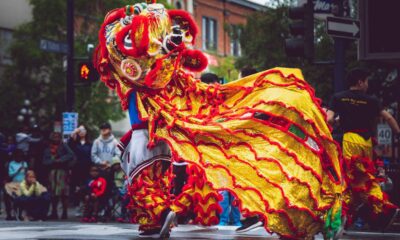blog
How to Make Caramel: A Delicious Guide
Published
5 months agoon
By
Yash-
Table of Contents
- How to Make Caramel: A Delicious Guide
- The Science Behind Caramelization
- Ingredients You’ll Need
- Step-by-Step Instructions
- Step 1: Preparing the Sugar
- Step 2: Heating the Mixture
- Step 3: Monitoring the Temperature
- Step 4: Adding Cream and Butter
- Step 5: Adding Flavor (Optional)
- Step 6: Cooling and Storing
- Flavor Variations
- Q&A
- Q: Can I use brown sugar instead of granulated sugar?
- Q: Can I reheat caramel if it becomes too thick?
- Q: How can I prevent crystallization when making caramel?
- Q: Can I use caramel in savory dishes?
- Q: Can I freeze caramel?
- Summary
Are you craving something sweet and indulgent? Look no further than caramel! This delectable treat is loved by people of all ages and can be used in a variety of desserts and confections. In this article, we will guide you through the process of making caramel from scratch. From understanding the science behind caramelization to exploring different flavor variations, we have got you covered. So, let’s dive in and learn how to make caramel like a pro!
The Science Behind Caramelization
Before we jump into the recipe, it’s important to understand the science behind caramelization. Caramelization is a chemical process that occurs when sugar is heated to a high temperature. As the sugar molecules break down, they undergo a series of complex reactions, resulting in the formation of a rich, golden-brown syrup with a distinct flavor.
During caramelization, the sugar molecules undergo a process called pyrolysis, which involves the breakdown of larger sugar molecules into smaller compounds. This process creates hundreds of different flavor compounds, giving caramel its unique taste and aroma.
Ingredients You’ll Need
Now that we understand the science behind caramelization, let’s gather the ingredients needed to make caramel:
- 1 cup granulated sugar
- 1/4 cup water
- 1/2 cup heavy cream
- 2 tablespoons unsalted butter
- 1 teaspoon vanilla extract (optional)
Step-by-Step Instructions
Follow these simple steps to make your own homemade caramel:
Step 1: Preparing the Sugar
In a heavy-bottomed saucepan, combine the granulated sugar and water. Stir gently to moisten the sugar evenly. It’s important to use a heavy-bottomed saucepan to ensure even heat distribution and prevent the sugar from burning.
Step 2: Heating the Mixture
Place the saucepan over medium heat and let the mixture come to a boil. Avoid stirring the mixture at this stage, as it can cause the sugar to crystallize. Instead, swirl the pan gently to distribute the heat evenly.
Step 3: Monitoring the Temperature
As the mixture heats up, it will start to change color. Use a candy thermometer to monitor the temperature. Caramelization occurs between 320°F (160°C) and 350°F (177°C). Once the mixture reaches the desired temperature, remove it from the heat immediately to prevent burning.
Step 4: Adding Cream and Butter
Carefully pour the heavy cream into the caramelized sugar mixture. Be cautious, as the mixture will bubble vigorously. Stir gently until the cream is fully incorporated. Next, add the unsalted butter and continue stirring until it melts completely.
Step 5: Adding Flavor (Optional)
If desired, you can enhance the flavor of your caramel by adding a teaspoon of vanilla extract. Stir well to combine.
Step 6: Cooling and Storing
Allow the caramel to cool for a few minutes before transferring it to a heatproof container. Once cooled, you can store it in an airtight jar in the refrigerator for up to two weeks.
Flavor Variations
Caramel is incredibly versatile, and you can experiment with different flavors to create unique variations. Here are a few ideas to get you started:
- Salted Caramel: Add a pinch of sea salt to the caramel mixture for a delightful sweet and salty combination.
- Chocolate Caramel: Stir in a tablespoon of cocoa powder or melted chocolate to create a luscious chocolate caramel sauce.
- Espresso Caramel: Infuse your caramel with a tablespoon of strong brewed coffee or espresso for a rich and aromatic flavor.
- Coconut Caramel: Mix in some shredded coconut to add a tropical twist to your caramel.
Q&A
Q: Can I use brown sugar instead of granulated sugar?
A: While brown sugar can be used to make caramel, it will result in a slightly different flavor and color. Brown sugar contains molasses, which adds a hint of caramel-like flavor to the final product.
Q: Can I reheat caramel if it becomes too thick?
A: Yes, you can reheat caramel by placing it in a heatproof bowl and microwaving it in short intervals, stirring in between. Alternatively, you can reheat it on the stovetop over low heat, stirring constantly until it reaches the desired consistency.
Q: How can I prevent crystallization when making caramel?
A: To prevent crystallization, make sure there are no sugar crystals on the sides of the saucepan before heating the sugar and water mixture. Additionally, avoid stirring the mixture until it starts to boil.
Q: Can I use caramel in savory dishes?
A: Absolutely! Caramel can add a touch of sweetness and depth of flavor to savory dishes like sauces, glazes, and marinades. It pairs particularly well with meats like pork and chicken.
Q: Can I freeze caramel?
A: Yes, you can freeze caramel for up to three months. Make sure to store it in an airtight container and thaw it in the refrigerator before using.
Summary
Making caramel from scratch is a rewarding and delicious experience. By understanding the science behind caramelization and following a few simple steps, you can create your own homemade caramel sauce. Whether you prefer classic caramel or want to experiment with different flavors, the possibilities are endless. So, gather your ingredients, put on your apron, and get ready to indulge in the sweet and velvety goodness of homemade caramel!
You may like
Mobility Scooter


Enhance Your iPhone with Adorable Cute Wallpapers
Looking to jazz up your iPhone screen with some cuteness? Discover the impact of adorable wallpapers on your device's look...


Glow Berry Prime: The Science Behind its Skincare Revival
Discover the transformative power of Glow Berry Prime in skincare with its potent blend of 20% Vitamin C, 2% Hyaluronic...


Glov Beauty: Eco-Friendly Products Review | Glov Beauty Reviews
Discover Glov Beauty's eco-friendly products like the Glov On-The-Go set with 500+ uses and the gentle exfoliation offered by the...


Unlocking Drake’s FPS Lyrics: How Gaming Influences His Music
Discover how Drake's lyrics in the first-person shooter-inspired track "War" reflect the influence of FPS games on his music. With...


Defeating a Fire-Breathing Dragon: Strategies for Mage Survival
Prepare yourself for an intense battle as we explore how to face a dragon capable of reaching temperatures over 2000°F....


Exploring Student Life at Glitties Eckerd College
Discover the dynamic student experience at Glitties Eckerd College with a plethora of club options, competitive sports, and community service...


Discover Success Stories with Money6x Real Estate Strategy
Discover the lucrative world of real estate investing with Money6x strategy! Uncover real-life success stories of investors achieving impressive 8-12%...


Get an Inside Look at Julion Alvarez’s 2024 USA Tour
Discover the meticulous planning behind Julion Alvarez's 2024 USA tour! Dive into the world of setlist curation, choreography design, and...


Enhancing Connections through Diversity & Active Listening
Learn how treating peers with empathy and actively listening can enhance relationships and boost innovation. The article emphasizes the significance...


Unlock Your Writing Potential with Draftle Unlimited
Discover how Draftle Unlimited revolutionizes writing with its convenient platform integration. From WordPress to Google Docs and Microsoft Word, writers...
